The HTC One (M8) Review
by Anand Lal Shimpi & Joshua Ho on March 26, 2014 7:00 PM EST- Posted in
- Smartphones
- HTC
- Mobile
- HTC One
Battery Life
The new One features an integrated 3.8V 2600mAh battery (9.88 Wh), a 13% increase in capacity compared to the previous model. The battery comparison isn’t that simple however. The M8 has a larger display (5” vs 4.7”) but it also has a higher performing and more power efficient SoC (Snapdragon 801 vs. 600). To find out how the new One stacks up against its predecessor, we turn to a mix of old and new battery life tests to help better characterize the device.
We’ll start with our standard browser based battery life tests. Keep in mind here these tests are as much about replicating a particular CPU profile as they are about loading specific web pages in order.
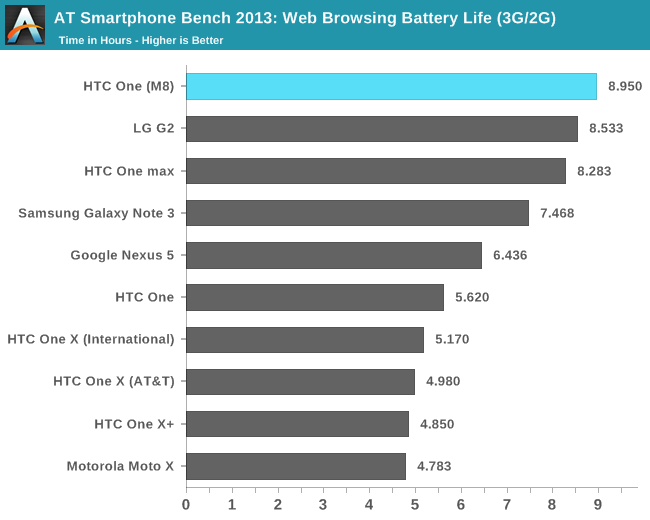
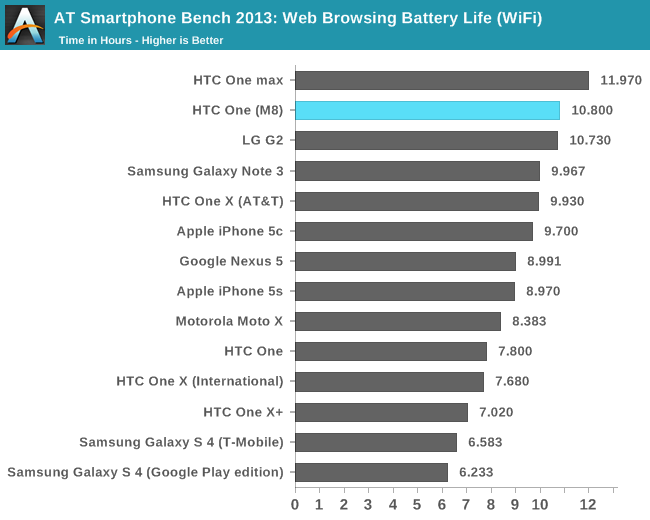
We saw a substantial gain in battery life with Snapdragon 800, and 801 extends that even further. For the same, relatively light (yet constant) workload, the M8 improves battery life over the M7 by as much as 71%. On WiFi the advantage drops to only 38%, but we’re still talking about absolutely huge generational gains.
A constant workload is only one part of the story though. More often than not, when you’re faced with faster compute you end up doing more. To see what the other extreme of battery life looks like I turned to two canned tests: BaseMark OS II and GFXBench 3.0.
I ran both of these tests under the same controlled conditions we always use, with all displays calibrated to 200 nits. BaseMark OS II runs through a bunch of CPU and storage benchmarks (basically the same tests used for the BaseMark OS II system and memory tests), as fast as possible, until the battery dies.
I like this benchmark as it gives us an indication of worst case battery life if you’re absolutely hammering the CPU (and storage) relentlessly.
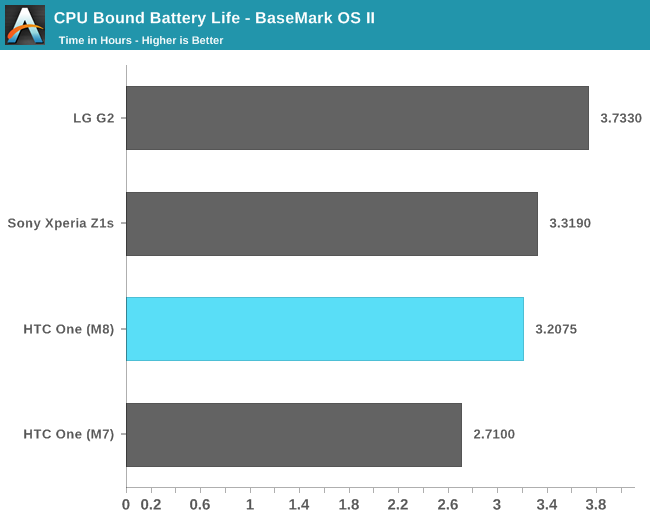
Despite the faster CPU cores, the M8’s battery life actually goes up compared to M7. Here we’re really seeing the benefits of 801’s updated 28nm HPm process compared to the Snapdragon 600’s 28nm LP process.
GFXBench provides a similar test, with effectively uncapped performance (on today’s devices at least since we’re not hitting v-sync limits), but stressing the GPU instead of the CPU. Here we’re running the T-Rex HD benchmark, onscreen, until the battery dies.

This is the first and only test we’ve got here that shows a regression in battery life compared to M7. The M8 loses about 6% of runtime compared to the M7, despite having a larger battery. Now look at what happens if we look at performance at the end of the run:
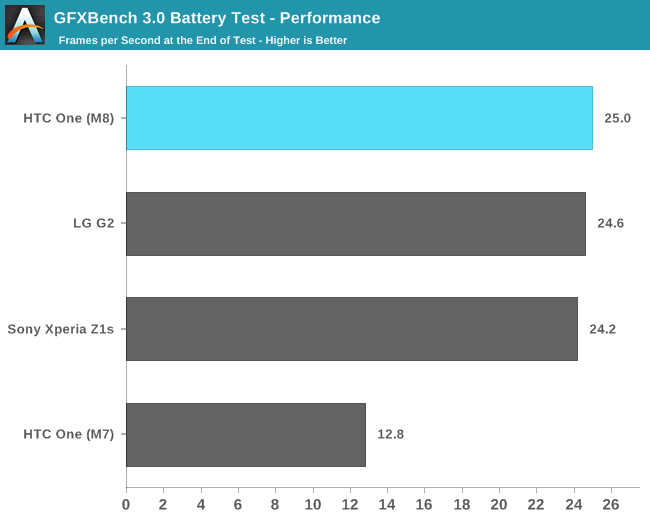
Now the M8’s battery life regression doesn’t look so bad. You give up 6% of runtime but you get almost twice the performance compared to M7. Snapdragon 801 is just a huge upgrade compared to 600.
Charge Time
The M8 features a Qualcomm Quick Charge 2.0 enabled PMIC, which enables faster battery charge times through higher voltage charging. Unfortunately the in-box wall adapter is only Quick Charge 1.5 compliant so you'll only pull 7.5W from the wall. HTC expects to offer a Quick Charge 2.0 compliant power adapter later this year.
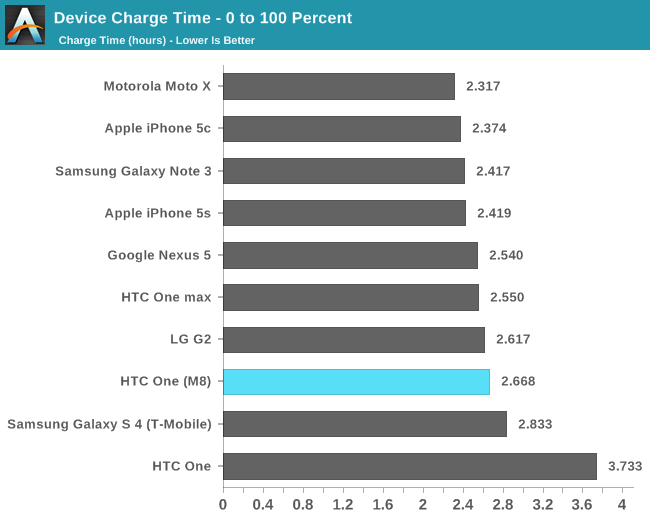
The M8's charge time is a bit slow compared to what we've seen from other devices with larger batteries.










222 Comments
View All Comments
althaz - Wednesday, March 26, 2014 - link
Why are the OLED screens not listed in the brightness for black and contrast tables? Yes, they have zero black levels and infinite contrast, but that's the level LCDs should be aspiring to and it's worth comparing them, IMO.There's a reason most people go for OLED screens (despite almost every reviewer preferring LCDs), they have MUCH better contrast. IMO this is a serious flaw of all LCD phones and should be mentioned. Sure, the tradeoffs may well be worth the relatively poor contrast, but that's something each user has to decide for themselves.
Braumin - Wednesday, March 26, 2014 - link
There's not enough horizontal pixels to graph infinity.evonitzer - Saturday, March 29, 2014 - link
True, but it still seems like there should be some mention of that, or just putting them at the top a bit above the leader. When I was looking at HDTV's some years ago, black levels were of very high priority, hence me getting a plasma. To think we would have perfect blacks on phones and people would shrug just a few short years later ...hangfirew8 - Wednesday, March 26, 2014 - link
Great review, not enough reason to trade-up from my M7, especially given the OIS video difference.I'll repeat my request to review the matching car dock and car mode/launcher with each review. With so many places passing hands-off laws for drivers, this mode is more and more important, and is obviously not given enough attention by either OEM's or reviewers.
Besides car dock mode, I really think a BT test such be conducted against, say, a Pioneer, a Kenwood and some select factory auto receivers. Complaints about niggling sync or lag or other bugs are common, but if no one is reviewing these combinations systematically, the manufacturers of both the phones and the car audio systems are not going to do anything about it.
Think of it this way- many phones spend most of their screen-on operating time docked in a car dock or holder of some kind, and BT synced with the receiver. It is the second most common operating usage after sitting beside us on our desk or armchair.
SorryItsAThrowAway - Wednesday, March 26, 2014 - link
I disagree that Sense UI is the best experience "bar none." If you've only compared it to Samsung or LG - then, sure. That would be an obviously true statement. However other manufacturers have arguably far more usable designs. If we stay with the Western audience as this article so clearly does then the best examples would be Motorola recently and even more especially Sony.Even if these still somehow came up short to Sense (debatable) they are certainly not so far away from the strong wording this review claims.
dylan522p - Wednesday, March 26, 2014 - link
Moto isn't classified as a skin and Sony adds VERY VERY little features and a lot of pointless changes.SorryItsAThrowAway - Wednesday, March 26, 2014 - link
I disagree. If it isn't stock then it's a skin. Moto is very minimal. Sony as well but they also have an entire theme system to change things like the appearance of the on-screen interface buttons. So, Sony can go either way with that in mind (good or bad).rxzlmn - Wednesday, March 26, 2014 - link
That's wrong. Sony keeps the main UI elements all the same, but does add many little helpful things. But they don't change how things behave and look in terms of usability compared to stock (different from HTC, LG or Samsung).CoryWeston101 - Monday, March 31, 2014 - link
No. Sense is the best user experience and best UI. No other Android OEM comes close. Motorola's UI is just stock with some added stuff. And Sony has a good UI but it isn't better than Sense.icwhatudidthere - Wednesday, March 26, 2014 - link
Actually that photo of you in the bar is how normal bokeh would look as well. Everything in your plane should be in focus, in this case, the second sensor is doing its job correctly and rendering a more realistic bokeh instead of a software-only solution.There is one artifact though on the wall paneling close to the table. I guess they're not actually assigning depth values to individual pixels but grids instead for faster processing.